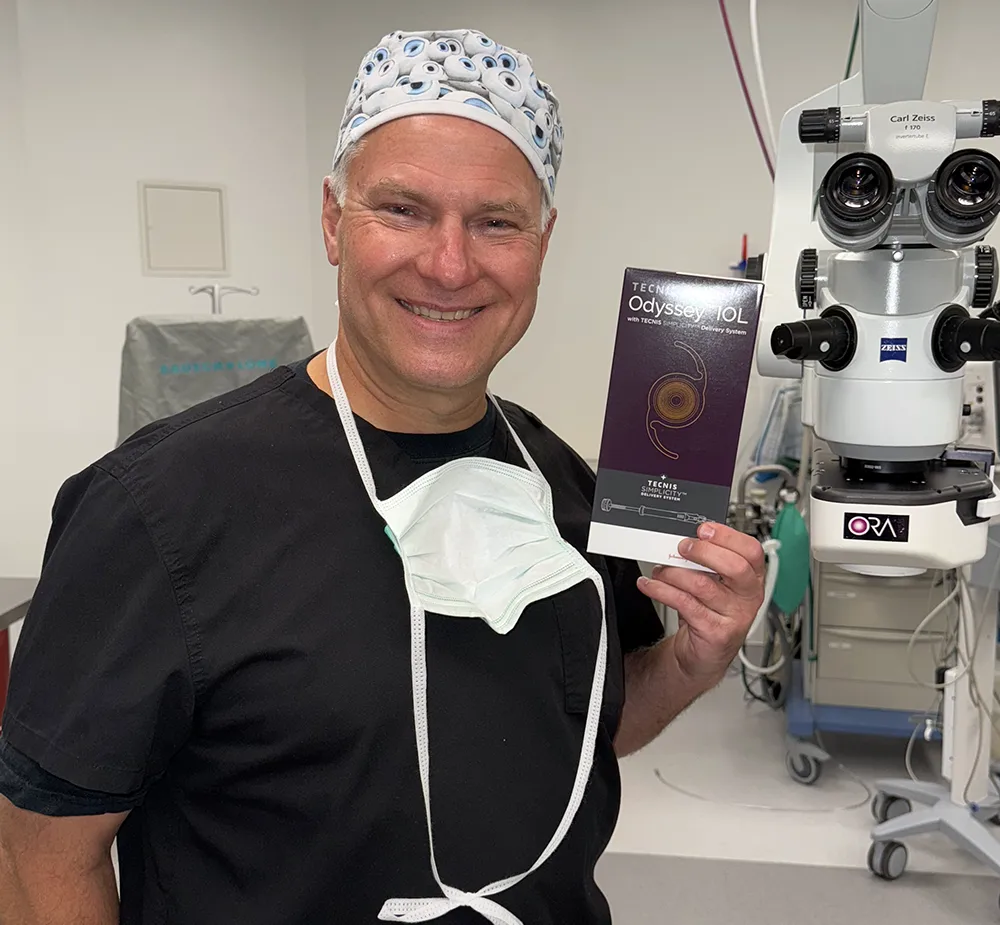Intraocular Lens Options (IOLs)
A New View… A New You
If you are seeking treatment for cataracts, we understand that you may have a lot of questions, especially about your lens options. We are here to answer them, and also to reassure you that it is an exciting time to have cataract surgery. There are better options than ever before to restore your sight.
At Kovach Eye, our experienced cataract surgeons offer customizable lens options for cataract patients in Chicagoland. We also offer refractive lens exchange (RLE) so you can take advantage of IOLs to treat presbyopia and improve your vision, even if you don’t have cataracts. Using the most advanced technology, we can help restore your sight to the optimal level, keeping your lifestyle and visual goals as our priority.
- What is an IOL?
- How Are Standard IOLs Different From Advanced IOLs?
- Standard Monofocal IOL
- Astigmatism-Correcting IOLs
- Presbyopia-Correcting IOLs
- Accommodating Lenses
- Multifocal and Trifocal Lenses
- Extended Depth of Focus (EDOF) IOLs
- Presbyopia-Correcting IOLs for Refractive Lens Exchange Surgery
- Light Adjustable Lens (LAL)
What is an IOL?
An intraocular lens implant, or IOL for short, is a small lens that is designed to replace the eye’s natural lens. When cataracts occur, they cause your natural lens (and your vision) to become cloudy. During cataract surgery, your eye doctor will remove the clouded lens and replace it with an IOL that has been chosen specifically for your vision needs. IOLs are also used in RLE surgery, which is a vision correction procedure for patients who are seeking a reading vision solution. There are two main categories of IOLs: standard (monofocal) IOLs and advanced IOLs.

Standard Monofocal IOL
A standard IOL is a monofocal lens that corrects vision at a single distance. Patients who receive a standard IOL will usually select one that corrects their distance vision, which means that they will still need to wear glasses for any intermediate or near vision needs. Standard IOLs are a covered expense on most insurance plans.
How Are Advanced IOLs Different From Standard IOLs?
Advanced IOLs, also called lifestyle lenses or premium lenses, are optimized to offer more comprehensive vision correction than a standard IOL. There are many types of advanced lenses, including lenses that correct at multiple distances, correct for astigmatism, and correct for presbyopia. The goal of many advanced lenses is to reduce or eliminate your need for glasses or contact lenses. Advanced IOLs may also reduce your chances of common side effects such as glare or halos. Advanced IOLs are typically an out-of-pocket expense, but they can vastly improve vision and overall quality of life.
Your surgeon will help you choose the best IOL based on factors such as whether you want to reduce your dependence on glasses, correct astigmatism, or enhance both near and distance vision. A thorough evaluation will determine the IOL that aligns with your vision goals and lifestyle.
Average
Not Included
May Experience
Included
May Experience
Included
May Experience
Included
Best
Not Needed
Average
Not Included
May Experience
Included
May Experience
Included
May Experience
Included
Best
Not Needed
Please note: The standard monofocal IOL lens is covered by insurance. Advanced technology lenses and the use of the femtosecond laser for cataract surgery are out-of-pocket expenses and are not covered by insurance. Patient is required to pay deductible and co-pay. Deductible and co-pay vary with insurance type.
Astigmatism-Correcting IOLs
Astigmatism happens when your cornea or lens has a different shape than normal. The shape makes light bend differently as it enters your eye, causing a refractive error. Astigmatism causes blurry vision that can be corrected with several different IOLs. An astigmatism-correcting IOL is called a toric lens. There is a toric monofocal lens that can correct vision at a single distance plus correct astigmatism. There are also several advanced toric lenses that can correct vision at multiple distances while also correcting astigmatism.
Presbyopia-Correcting IOLs
Presbyopia, also known as age-related near vision loss, affects most people over the age of 45. Reading glasses or multifocal glasses can help with reading vision, but many people would like a solution that enables them to escape the hassle of reading glasses. Luckily there are a variety of advanced IOLs that can treat presbyopia.
Accommodating Lenses
An accommodating IOL is an innovative lens that is designed to mimic the eye’s natural focusing ability. This type of advanced presbyopia-correcting IOL moves with the eye, shifting as you shift your focus, in order to correct at multiple distances and allow for better reading vision.
Multifocal and Trifocal Lenses
Multifocal and trifocal IOLs are advanced lenses that can correct vision at multiple distances. These IOLs have a unique design. Concentric rings are etched onto the surface of the lens, with a different prescription in each ring—allowing for improvement of near, intermediate, and distance vision.
Extended Depth of Focus (EDOF) IOLs
An extended depth of focus, or EDOF, IOL is an advanced lens that elongates the eye’s focal point in order to create a range of vision. By creating a single elongated focal point, an EDOF lens can correct at multiple distances without requiring the brain to adapt between different prescriptions.
Presbyopia-Correcting IOLs for Refractive Lens Exchange Surgery
Presbyopia-correcting lenses can reduce or eliminate your need for reading glasses, while also correcting other refractive errors. Looking for a reading vision solution, even if you don’t have cataracts? Patients who do not have cataracts can opt for RLE surgery, a LASIK alternative that is a great option for patients in their 40’s to 60’s.
Light Adjustable Lens (LAL)
The Light Adjustable Lens (LAL) by RxSight is an advanced intraocular lens (IOL) designed for patients seeking a fully customizable vision correction option. Unlike traditional IOLs, the RxSight LAL is made with a specialized photo-sensitive material that allows adjustments to be made after cataract surgery.
Approximately 2 to 3 weeks after your procedure—once your eyes have healed—your doctor will assess your vision and fine-tune the lens prescription using the RxSight Light Delivery Device. This simple, non-invasive, in-office procedure uses UV light to precisely adjust the lens to match your vision needs. Additional UV treatments may be scheduled to further refine your results, offering a level of customization unavailable with other IOLs.
The Light Adjustable Lens is the only IOL that allows for post-surgical adjustments, giving patients more control over their vision outcome, whether for distance vision or blended vision.
Learn More About Cataract Surgery
A comprehensive cataract consultation is the best way to explore your options and determine the right treatment for your vision needs. Our experienced surgeons will assess your eyes, discuss advanced surgical technologies, and help you choose the most suitable approach.
Get started on your path to clear vision. We have four convenient locations in Illinois: Elmhurst, Naperville, South Barrington, and Lincolnwood. Schedule a consultation today by calling us at 630-517-9312 or request an appointment.

The doctors at Kovach Eye Institute have either authored or reviewed and approved this content.
Page Updated: